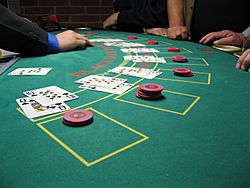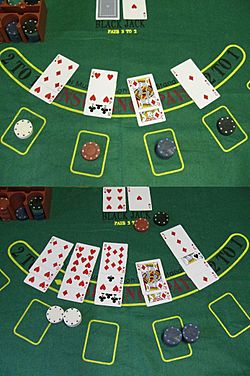Blackjack facts for kids
Blackjack (Twenty-one, pontoon or Vingt-et-un) is a kind of card game which usually involves gambling. It is often played in casinos. There is a dealer, who deals cards from a special device called a 'dealer's shoe' or a 'shuffling machine'. The dealer has one to eight decks. When there are one or two decks, the dealer usually holds the decks instead of dealing from a shoe.
It is a 'dealer versus players game'. Each player has their own game against the dealer. Cards are dealt in succession, and bets placed for each hand. Players win if their cards add up to more than the dealer's hand to a limit of 21. Hands which add up to more than 21, called busted hands, lose. Face cards count as 10. Aces can count as one or eleven.
'Blackjack', an ace and a face card or ten, is the top scorer. Blackjack usually pays a bonus. Five cards adding to 21 or fewer is the next ranking hand. Apart from that, unbusted hands rank by total add-up. Hands below the dealer's hand lose unless the dealer goes over 21 (busts). Hands equal to the dealer's keep their chips. If both the player and dealer bust, the dealer wins.
Players have a choice whether or not to get extra cards. Stand means to get no more cards and hit means to ask for another card. To stand, wave your hand back and forth. To ask for another card, wave your hand toward you. You can ask for any number of cards unless you bust. The dealer has rules as to when he takes extra cards for himself (or herself). In the UK, the dealer must stand on 16. These rules are set by the casino and cannot change after the game has started. In some states or countries, the rules are set by the government.
There is some skill in blackjack, because the odds change as the cards are dealt. The critical information is the numbers of tens (including face cards) which have been dealt. This is because they are the common cause of 'busting' the dealer hand and because they are needed for a blackjack. Aces are also important because they are needed for a blackjack. Keeping track of the cards is called 'card counting'. It is legal if done without a device like a computer. But, many casinos tell players to leave if they think are counting the cards.
History
Over the years the origin of Blackjack, like many other games, has eluded researchers for a long time and which continues to be hotly debated to this day. Till date there has been no clear consensus, but most agree it probably originated in French casinos around 1700, where it was called Vingt-et-Unwhich, translated, means twenty-one. Most believe it was probably derived from the French card games, Chemin de Fer, and French Ferme, which were in vogue at that time. Another of its version was prevalent in Spain, which was called 'One and Thirty'. The basic rule of the Spanish version was to reach 31 with a minimum of three cards.A theory that's also doing the rounds is that Blackjack was an invention by the Romans. It is believed that Romans used to play this game with wooden blocks of different numerical values. This theory holds some weight as Romans loved gambling, but that by no means confirms the theory. Among the various versions of the game, 'Vingt-et-Un' or '21' continued to grow in popularity and reach. It gradually spread to North America thanks to French colonists and soon after it was played throughout the continent. The rules of Blackjack were then different from those of modern or contemporary Blackjack. Just to elaborate, in this form of Blackjack, only the dealer was permitted to double. Also, a betting round was there between each of the playing cards dealt.The game was still termed '21' when it gained popularity in Nevada in 1931 as the State first chose to make gambling legal. Its origin is disputed, but it is certainly related to several French and Italian gambling games. In Britain since World War I, the informal game has been called pontoon. To draw more people to the game, some casinos then offered a special bet: A hand featuring either of the black jacks (the Jack of Spades or that of Clubs) plus the Ace of Spades would pay 10-to-1 odds on the lucky player's bet. Although casinos later discontinued this peculiar payout, the name 'blackjack' or 'black jack' remained, as the game is known today. Five of Clubs: "Watson’s card". The name has nothing to do with Sherlock Holmes but refers to a famous gambler who is supposed to have won £10,000 at Faro through his wager in connection with this card.Blackjack was not conceived by any one person at one definite point of time. On the contrary, blackjack has evolved over centuries; it continues to evolve and grow even today, thanks to the Internet. Fuelling its popularity the online casino industry has developed various versions of the game which has truly revolutionized it. Now a few reputed casino operators have started an innovative and far more enjoyable concept of this game: live blackjack game with real dealers. Live Blackjack is the most advanced way to play your favourite casino game right in the comfort of your home, without having to go a long way to a field-based casino.
Blackjack example
This is an example of a Blackjack game. Players are named by gambling chip colour: white, brown, blue and black.
The dealer has given two cards each to the four players who are betting. One of the dealer's two cards is face-up so all the players can see it (an Ace), and the other is face down.
- Black gets an Ace and 2 which is worth either 13 or 3, and asks for a hit and gets a King (worth 10) which takes black to 13; black hits again, gets 16 and decides to stand.
- Blue gets a King and Jack which are worth 20 together and of course chooses to stand. (Splitting a K and J may be possible in some games although it is unusual to split a 20 because it is such a high hand)
- Brown gets a 10 and 4, and asks for a hit, gets 2 which takes brown to 16. Another hit and they get a 10, which means they are bust at 26 and the dealer takes the chips. Normally the cards would be taken away immediately with the bet.
- White gets two 5s, so they double the bet and split the cards, the dealer gives them a 5 and a 7 for each. They ask for hits in both cases and get a 9 and 6, taking them to 21 and 16 respectively.
The dealer turns their card over and gets a 6, together with the Ace takes them to 17, and stands because the dealer must stand on 17. (In this case the dealer must stand on a "soft" 17). Results:
- Black loses their chips because the dealer's 17 beats black's 16
- Blue is paid the same amount of chips they bet because blue's 20 beats the dealer's 17
- Brown has already lost their chips when they went bust
- White's 21 is paid at 2:1, which means that white receives double and a half the amount of chips white bet for one of the splits, however white loses the other half of chips bet on the 16 which is beaten by the dealer's 17. Most games do not pay 2:1 for a hand of 21 however. The strongest scoring 21 would be an ace card and any other 10-point card. You can actually get to 21 in many different ways, but the ace and 10-point card combination will beat those variations.
Variations
- Base (American): with one dealer's open card and one hole card. With an open ace or a dozen (in some variations only with ace), the dealer looks at the hidden card and, if the blackjack dealer, the game ends.
- European: the dealer takes the second card after all players finish the set. In the case of a blackjack dealer, the players are returned all additional bets (except for "insurance"),
- On the basis of Blackjack, numerous versions have been created, with their own names such as Blackjack in the open (Double Exposure), 3-Card Blackjack, Blackjack Switch, Spanish 21, Caribbean 21, Super Fan 21, Pontoon, etc.[1]
Images for kids
-
A video blackjack machine at Seven Feathers Casino.
See also
 In Spanish: Blackjack para niños
In Spanish: Blackjack para niños






